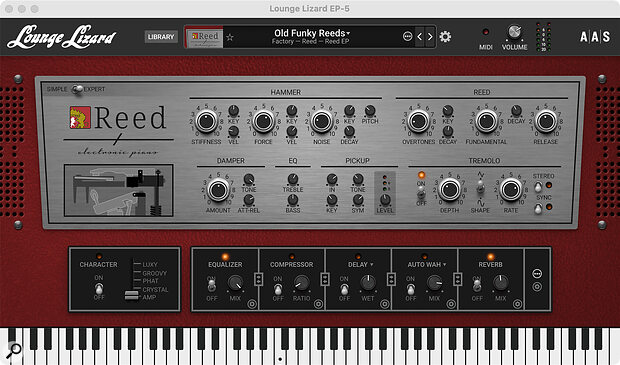Rating: ★ ★ ★ ★ ★ 5/5 Stars
Applied Acoustics Systems’ Lounge Lizard has long been a go‑to software instrument for musicians seeking authentic electric piano sounds without the bulk and upkeep of vintage hardware. With version 5, the developers have taken things further, reworking the engine and introducing a split design that now offers both tine‑ and reed‑based models. The result is a versatile package that caters equally to players chasing classic Rhodes warmth or the grit and bite of a Wurlitzer. An added bonus is the ability to resize the interface, and the diagram of the mechanism for each model is a nice touch too.
The updated sound library makes auditioning patches quicker than ever, with instant preview functionality and clear categorisation. You can browse by engine type (tines or reeds), sound category, or even load expansion packs and user presets. It’s an inviting workflow that gets you to the right tone fast, whether you’re scoring, producing or simply jamming.
The tine model features both a Simple and an Expert view, making it accessible for newcomers while offering depth for sound designers. The Hammer section allows you to shape the velocity curve, adjusting how the instrument responds to your touch. Moving into the Fork section, you can dial in anything from harder, bark‑like attacks to softer, bell‑like tones.
The Damper control softens and rounds off harsher sounds, especially useful when sculpting shimmering bell‑style patches. Meanwhile, the Pickup module lets you experiment with drive and tone, while the Character control enhances specific timbral traits for added colour. A dedicated two‑band EQ further fine‑tunes the sound and the Tremolo section convincingly emulates the classic stereo panning wobble, from subtle movement to swirling motion.
The reed model, inspired by Wurlitzer‑style instruments, similarly comes with Simple and Expert views. In its simplest form, you get quick access to treble, bass and tremolo controls, ideal for fast results. Switch to Expert mode and things open up: the Hammer and Reed modules allow you to shape harmonics and overtones, adding everything from bell‑like shimmer to a gritty, overdriven growl. The Damper once again provides control over sustain character, while EQ, pickup response and tremolo round out the palette.
Both engines share a flexible effects section. You can chain up to five effects, with three fixed slots (EQ, Compression and Reverb) and two customisable ones for Phaser, Chorus and more. Parameters can be tweaked via pop‑up windows, letting you go deep if needed. Between the onboard EQ, drive, modulation and ambience effects, you can keep most processing within EP‑5 itself, reducing reliance on external plug‑ins.
Lounge Lizard EP‑5 really captures the personality and vibe of vintage reed and tine pianos.
Despite being a modelled instrument, Lounge Lizard EP‑5 really captures the personality and vibe of vintage reed and tine pianos. Its interface is both simple yet flexible, delivering classic tones or modern variations with ease. For producers, songwriters and performers, it’s a worthy upgrade that’s going to keep this instrument as a firm favourite.

